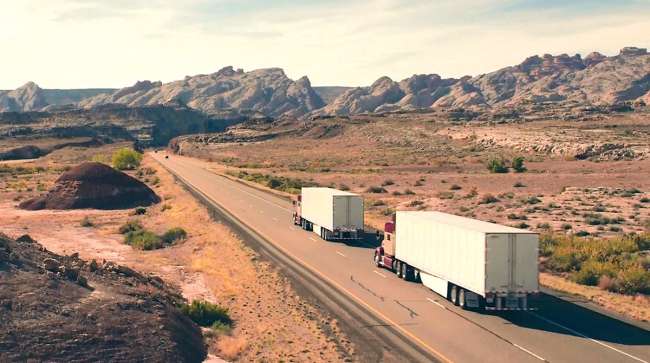Managing Editor
Can Bridges Handle Weight of Platooning Trucks? Engineering Firm Wants to Know

WASHINGTON — While truck-to-truck communication, driver training and safety have advanced the effort to hasten platooning to market, another critical aspect is looming and just may cause this momentum to slow: the impact on infrastructure.
The relatively close distance that must be maintained between the vehicles in a platoon — in which a lead vehicle is electronically tethered to a vehicle or vehicles closely trailing — means a greater amount of weight concentrated on smaller-than-usual portions of the road. The potential effects of this weight distribution on the nation’s roads must undergo intense study, researchers and engineers attending the National Academies of Sciences’ annual Transportation Research Board conference here said Jan. 7, especially as it relates to potential damage to bridges.
With platooning expected to be one of the first applications of autonomous vehicles to reach commercial use, these questions need answers soon, they said.

Dunne by Lorrie Grant/Transport Topics
“How do loads impact the physical plant? The deck, beams, joints, pavement are stressed by heavy vehicles moving closer and closer together,” said Richard Dunne, director of structures at Michael Baker International.
He cited the example of four-lane bridges in which two sets of platoons could travel side by side, adding stress to the roadway. “Do you break the platoon on a bridge? We need the research to [tell us],” Dunne said.
Based in Pittsburgh, Michael Baker International is an engineering and consulting services firm. It also develops codes used by the American Association of State Highway and Transportation Officials to develop bridge ratings.
Truck platooning is similar to a truck convoy except that the platoon of two or more trucks is connected electronically through direct short range communications that bring the vehicles to within close following distance (approximately 30 feet), according to American Trucking Associations. The platooning process uses sensors to collect data that control a truck’s braking system and speed. The technology makes use of a forward collision avoidance system and vehicle-to-vehicle communication to allow two trucks to travel close together, according to the federation.
Dunne, who presided over the TRB session “Truck Size and Weight: What You Need to Know,” said more is to be learned about what platooning means for road damage as well as whether a universal standard should be set for traveling distance between vehicles in a way that ensures bridge spans can handle the added weight.
“We should be looking at what 10-feet- to 20-feet-platoon loads look like to the bridge,” he said. “What’s the number of truck-trains, and what’s the span length?”
The United States has 614,387 bridges — four out of 10 of which are 50 years old or older, with about 9% rated as structurally deficient in 2016, according to a report from the American Society of Civil Engineers. In its most recent report card, the group graded the nation’s bridges with a C-plus and scored the nation’s overall infrastructure a D-plus.
The researchers and engineers maintain that examining the influence of truck platooning on bridge performance in a pre-emptive manner will pay off, noting that such studies will allow state departments of transportation to avoid unanticipated consequences that could result, such as durability issues, increased maintenance and serviceability failures.
Michigan is one state paying close attention. Trucks there can carry as much as 164,000 pounds on 11 axles, Aarne Frobom, a legislative specialist in the Michigan Department of Transportation’s Asset Management and Policy Division, told Transport Topics at the conference.

Frobom by Lorrie Grant/Transport Topics
“We have a lot of specialized carriers who haul massive loads,” he said, ticking off key commodities such as automotive powertrains, sugar beets, sheet steel and gasoline.
With so many valuable interests that feed its economy, the state sees the benefit of platooning.
In December, Michigan sanctioned automated motor vehicles and made an exception to its current required minimum following distance of 500 feet for commercial vehicles — removing a hurdle for truck platooning.
“We are committed to advancing safety and efficiency in commercial trucking operations and accelerating the economic benefits that result from improving the movement of goods,” Kirk Steudle, director of MDOT, said in a joint statement with Peloton Technology, which has tested truck platoons in the state.
The law also requires that truck platoons allow access for other vehicles to move safely between platooning trucks. In addition, drivers holding a valid commercial driver license must be behind the wheel of every truck in a platoon.
Also, truckers must have a permit from MDOT and the Michigan State Police before vehicles are allowed to platoon on the state’s roads, Frobom said.
Peloton demonstrated its platooning system in Michigan in September 2014. The company, which has dual headquarters in Lansing, Mich., and Mountain View, Calif., said it is preparing a general plan for platooning operations to submit to Michigan, and that 11 other states have approved testing.


